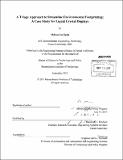| dc.contributor.advisor | Randolph E. Kirchain. | en_US |
| dc.contributor.author | Zgola, Melissa Lee | en_US |
| dc.contributor.other | Massachusetts Institute of Technology. Technology and Policy Program. | en_US |
| dc.date.accessioned | 2012-02-29T17:58:34Z | |
| dc.date.available | 2012-02-29T17:58:34Z | |
| dc.date.copyright | 2011 | en_US |
| dc.date.issued | 2011 | en_US |
| dc.identifier.uri | http://hdl.handle.net/1721.1/69482 | |
| dc.description | Thesis (S.M. in Technology and Policy)--Massachusetts Institute of Technology, Engineering Systems Division, 2011. | en_US |
| dc.description | Cataloged from PDF version of thesis. | en_US |
| dc.description | Includes bibliographical references (p. 64-69). | en_US |
| dc.description.abstract | Quantitative environmental performance evaluation methods are desired given the growing certification and labeling landscape for consumer goods. Challenges associated with existing methods, such as life cycle assessment (LCA), may be prohibitive for complex goods such as information technology (IT). Conventional LCA is resource-intensive and lacks harmonized guidance for incorporating uncertainty. Current methods to streamline LCA may amplify uncertainty, undermining robustness. Despite high uncertainty, effective and efficient streamlining approaches may be possible. A methodology is proposed to identify high-impact activities within the life cycle of a specific product class for a streamlined assessment with a high degree of inherent uncertainty. First, a screening assessment is performed using Monte Carlo simulations, applying existing activity (materials and processes), impact, and uncertainty data, to identify elements with the most leverage to reduce overall environmental impact uncertainty. This data triage is informed by sensitivity analysis parameters produced by the simulations. Targeted data collection is carried out for key activities until overall uncertainty is reduced to the point where a product classes' impact probability distribution is distinct from others within a specified error rate. In this thesis, we find that triage and prioritization are possible despite high uncertainty. The methodology was applied to the case study of liquid crystal display (LCD) classes, producing a clear hierarchy of data importance to reduce uncertainty of the overall impact result. Specific data collection was only required for a subset of processes and activities (22 out of about 50) to enable discrimination of LCDs with a low error rate (9%). Most of these priority activities relate to manufacturing and use phases. The number of priority activities targeted may be balanced with the level to which they are able to be specified. It was found that ostensible product attributes alone are insufficient to discriminate with low error, even at high levels of specificity. This quantitative streamlining method is ideal for complex products for which there is great uncertainty in data collection and modeling. This application of this method may inform early product design decisions and enable harmonization of standardization efforts. | en_US |
| dc.description.statementofresponsibility | by Melissa Lee Zgola. | en_US |
| dc.format.extent | 105 p. | en_US |
| dc.language.iso | eng | en_US |
| dc.publisher | Massachusetts Institute of Technology | en_US |
| dc.rights | M.I.T. theses are protected by
copyright. They may be viewed from this source for any purpose, but
reproduction or distribution in any format is prohibited without written
permission. See provided URL for inquiries about permission. | en_US |
| dc.rights.uri | http://dspace.mit.edu/handle/1721.1/7582 | en_US |
| dc.subject | Engineering Systems Division. | en_US |
| dc.subject | Technology and Policy Program. | en_US |
| dc.title | A triage approach to streamline environmental footprinting : a case study for liquid crystal displays | en_US |
| dc.type | Thesis | en_US |
| dc.description.degree | S.M.in Technology and Policy | en_US |
| dc.contributor.department | Massachusetts Institute of Technology. Engineering Systems Division | |
| dc.identifier.oclc | 775596010 | en_US |
